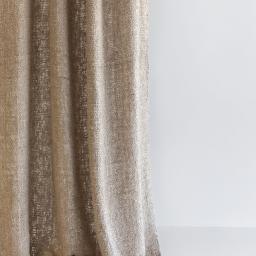An Insight into Viscose
Viscose, or Rayon, was the first regenerated fibre to be manufactured for commercial production in the early 1900s.
As a fabric, it is able to emulate the extremely soft handle and subtle sheen of natural fibres, whilst being more cost effective to produce. Therefore, resulting in the continued popularity of viscose in fashion and soft furnishings.
Although viscose begins as a natural fibre, it is different from products like linen and cotton because it undergoes a manufacturing process. During this process, wood pulp is dissolved in alkali to make the solution called viscose, which is then squeezed through a nozzle or spinneret into an acid bath to create filaments called regenerated cellulose, and finally spun into yarn.
As with all natural fibres, viscose has a unique personality and requires special care. In this article we will discuss the characteristics of this versatile fabric, whether it is the right choice for your next project, and its unexpected enemy – H2O.
Characteristics of Viscose:
• Soft Handle
• Luxurious appearance and subtle natural lustre.
• Viscose yarn absorbs and holds dye well. Especially when piece dyed, a viscose product has the ability to reflect vibrant and bold colour.
• Can be engineered to resemble other natural fibres such as linen cotton and silk, while in most instances, can be more cost effective.
• Absorbent fibre and less durable when wet. We recommend that fabric qualities with a high percentage of viscose yarn are not washed or spot cleaned with water. Due to the absorbent nature of the yarn, spot cleaning can result in watermarks occurring.
• Dry Cleanable. In most cases we recommend a professional dry clean for compositions with a high amount of viscose.
• Low thermal retention. This characteristic mostly applies to the fashion apparel industry. Being a cellulose based fibre, it does not retain heat as well.
• As with all natural fibres, viscose can be susceptible to fading in direct sunlight due to the extreme UV conditions in Australasia. We recommend you are mindful of where natural fibres are situated in the home. In a drapery situation we always recommend a quality lining.
• For interior textiles, a fabric with a component of viscose yarn is extremely versatile and can be used in drapery, upholstery and accessory applications. We don’t typically recommend viscose fabrics to be used for bedding due to the fibre generally being dry clean only.
• A fabric that contains a viscose component can have the same fabric dye processes, finishes and printing applications as other natural fibres.
Keep reading: www.curtainclean.co.nz...
Poll: Is it rude to talk on the phone on a bus?
Buses can be a relaxing way to get home if you have a seat and enough space. However, it can be off-putting when someone is taking a phone call next to you.
Do you think it's inconsiderate for people to have lengthy phone calls on a bus? Vote in the poll, and add your comments below.

-
64.2% Yes
-
33.2% No
-
2.6% Other - I'll share below
Unlock the Answer: Today’s Riddle is Trickier Than You Think!
What English word retains the same pronunciation, even after you take away four of its five letters?
Do you think you know the answer to our daily riddle? Don't spoil it for your neighbours! Simply 'Like' this post and we'll post the answer in the comments below at 2pm.
Want to stop seeing riddles in your newsfeed?
Head here and hover on the Following button on the top right of the page (and it will show Unfollow) and then click it. If it is giving you the option to Follow, then you've successfully unfollowed the Riddles page.

Tips on Accelerating Your Comfort Level with a New Mattress
Getting started on the quest for the perfect night’s sleep with a new mattress can be exciting, but it often requires a period of adjustment.
If you've recently invested in a new mattress and are wondering about the time frame for adjustment, you're not alone.
Understanding the typical adjustment period can greatly improve your sleep health and ensure you get the most comfort out of your new bed.
The Personal Touch: Individual Variation in Adjustment
When it comes to adapting to a new mattress, there's no one-size-fits-all answer.
The mattress adjustment period can vary significantly depending on a number of personal factors.
Age, health, and even your usual sleep position can influence how quickly you adjust.
Generally, most people take anywhere from a few days up to a month to fully adapt to their new sleeping environment.
During this time, your body is acclimating to the support and feel of the mattress, which may differ significantly from your old one.
Understanding Mattress Types and Their Impact
The type of mattress you choose also plays a crucial role in your adjustment period.
Memory foam, for instance, may require a longer adjustment period as it contours more significantly to your body compared to a traditional spring mattress.
On the other hand, hybrid mattresses—a combination of foam and springs—offer a balance of support and cushioning, which might ease the adaptation process.
Tips for a Smoother Transition
Adapting to your new mattress is not just about waiting it out; there are active steps you can take to make the process smoother:
Maintain a consistent sleep schedule. Going to bed and waking up at the same time every day sets your body’s internal clock, which can help reduce the adjustment time.
Create a comfortable sleep environment. Ensure your bedroom is conducive to sleep—consider factors like temperature, light, and noise.
Give it time. Even if your new mattress feels different or not quite right initially, give it a few weeks, as initial discomfort is common.
Exploring more about how to enhance your sleep environment for a comfortable sleep, you can check out Beds4U Bedding.
Recognizing the Signs of Successful Adjustment
How do you know if you're well-adjusted to your new mattress?
Look for positive changes in your sleep quality and health.
You should experience less tossing and turning, fewer awakenings through the night, and reduced morning stiffness or soreness.
Increased sleep quality and waking up feeling rested are clear indicators that your body has adapted to the new mattress.
Comfort with Confidence
Adjusting to a new mattress is a unique experience that varies from person to person.
By understanding your needs and the characteristics of different mattress types, along with employing tips to aid the transition, you can enhance your sleep quality significantly.
Remember, a good night's sleep is crucial for your overall health and well-being.
At Beds4U, we are committed to helping you find that perfect sleep solution.
With a wide range of high-quality mattresses and a knowledgeable team eager to assist, finding your ideal comfort is just a visit away.
Explore our latest collections and sales at Beds4U and start enjoying a more comfortable sleep tonight.









 Loading…
Loading…



























